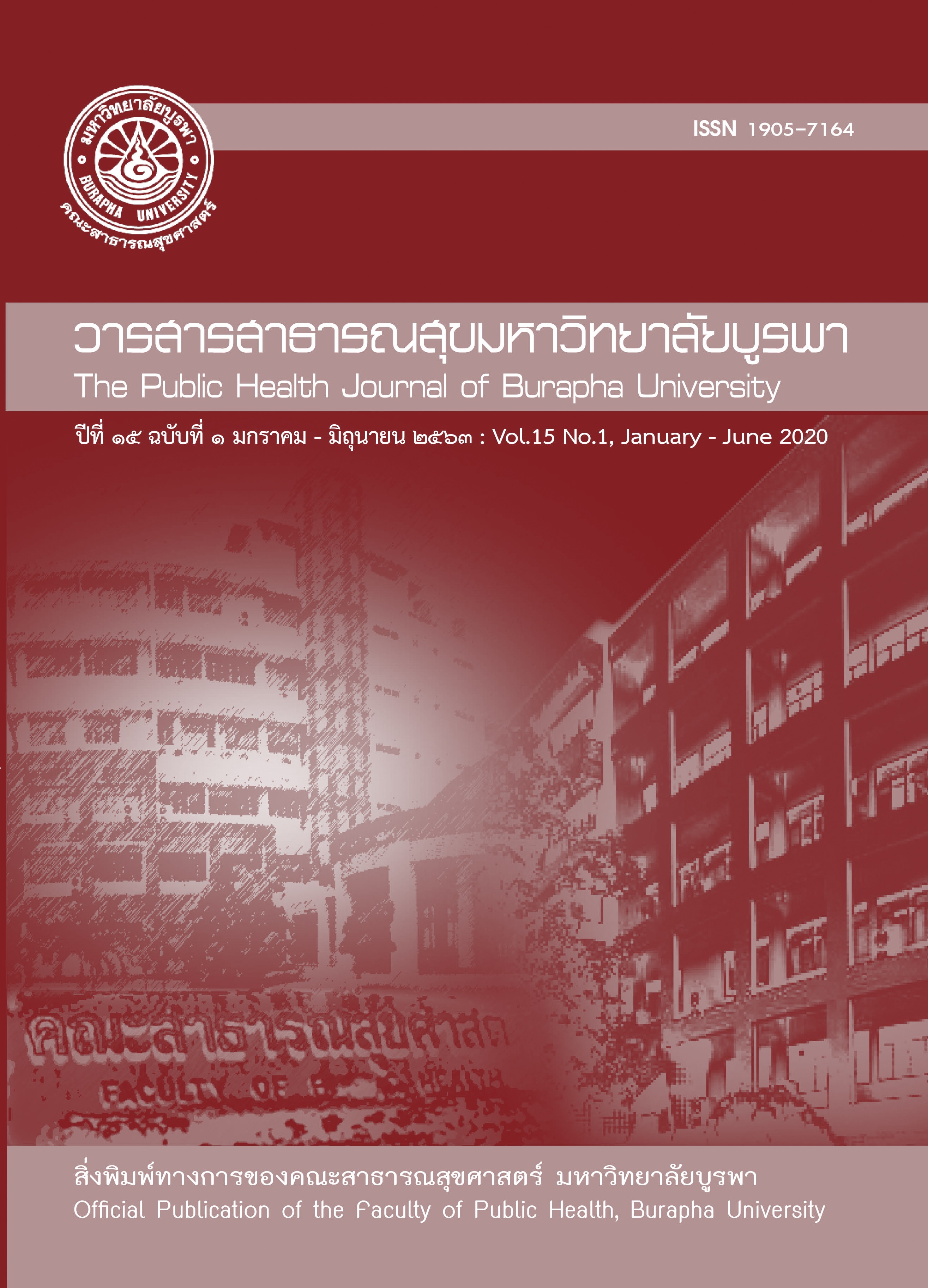เปรียบเทียบปริมาณการสัมผัสสารเบนซีนของผู้ประกอบอาชีพในสถานีบริการน้ำมันเชื้อเพลิง
Main Article Content
บทคัดย่อ
Comparison of Benzene Exposure among Occupations at Gasoline Service Stations in Khon Kaen Province
การศึกษานี้เป็นการวิจัยเชิงวิเคราะห์แบบภาคตัดขวาง (Cross – sectional analytical study) มีวัตถุประสงค์เพื่อเปรียบเทียบปริมาณการรับสัมผัสสารเบนซีนของผู้ประกอบอาชีพในสถานีบริการน้ำมันเชื้อเพลิงในจังหวัดขอนแก่น การรับสัมผัสสารเบนซีนได้จากการตรวจวัดปริมาณกรดมิวโคนิก (tran-tran Muconic Acid; t,t-MA) ในปัสสาวะก่อน และหลังปฏิบัติงาน ด้วยเทคนิค High Performance Liquid Chromatography (HPLC) จำนวนกลุ่มตัวอย่าง 139 คน คือ พนักงานเติมน้ำมัน 77 คน พนักงานเปลี่ยนถ่ายน้ำมันเครื่อง 33 คน แม่ค้า 29 คน ผลการศึกษาพบว่าหลังปฏิบัติงานแม่ค้ามีค่าเฉลี่ย t,t-MA สูงสุดคือ 609.76 ± 644.68 µg/g Cr. ค่าเฉลี่ยของผลต่างการรับสัมผัสในระหว่างปฏิบัติงาน (หลัง-ก่อน) พบว่าพนักงานเติมน้ำมันมีค่า t,t-MA สูงสุด 439.04 ± 972.95 µg/g Cr. ความเข้มข้นของสารเบนซีนในบรรยากาศการทำงานมีค่าเฉลี่ย 0.0047 ± 0.0031 ppm. เปรียบเทียบปริมาณ t,t-MA ก่อน และหลังปฏิบัติงานพบว่าแตกต่างกันอย่างมีนัยสำคัญทางสถิติ (p < 0.05) เปรียบเทียบ t,t-MA กับค่าแนะนำของ American Conference of Governmental Industrial Hygienists (ACGIH) พบว่ากลุ่มผู้ประกอบอาชีพมีปริมาณ t,t-MA สูงเกินกว่าค่าแนะนำร้อยละ 29.50 ดังนั้นจึงควรทำการเฝ้าระวังการรับสัมผัสสารเบนซีนอย่างต่อเนื่อง และศึกษาปัจจัยที่ส่งผลต่อการรับสัมผัส
This study was a cross-sectional analytic study aimed to investigate benzene exposure among three occupations at gasoline service stations. The amount of benzene exposure of the working group in the gasoline service stations was obtained from the detection of tran, tran-Muconic Acid (t,t-MA) with the high performance liquid chromatography (HPLC) technique. There were 139 people working in fuel service stations included into the study as refueling worker (n=77), car care workers oil changed (n=33) and merchant/ seller in mini mart (n=29). The results of the study showed that after shiftwork, the merchants had the highest mean t,t-MA 609.76 ± 644.68 µg/g Cr. Considering the different of t,t-MA concentration after shiftwork compared to before shiftwork, the engine car care worker had the highest mean t,t-MA (439.04 ± 972.95 µg/g Cr), The average concentration of benzene in the working environment was 0.0047 ± 0.0031 ppm. Comparison results of benzene exposure before and after work shift, found that benzene exposure was statistically different (p < 0.001). Comparison results to recommendation of ACGIH, the results showed that the median value was not more than the recommendation. Considering the number of people who have the t,t-MA value higher than the recommended value after shiftwork, there were 41 people, accounting for 29.50 %. Therefore, health and environmental monitoring for exposure to benzene should be conducted. Factors affecting benzene exposure among the gasoline station workers should be studied.
Article Details
เอกสารอ้างอิง
2. International Agency for Research on Cancer [Internet]. 2016.[cited 2017 Aug 19]. Available from: https://monographs.iarc.fr/list-of-classifications.
3. สำนักจัดการคุณภาพอากาศ และเสียง กรมควบคุมมลพิษ.(2558). สรุปผลการตรวจวัดสารอินทรีย์ระเหยง่าย (VOCs). ค้นเมื่อ 15 สิงหาคม 2560.จาก http://aqnis.pcd.go.th /vocs
4. สำนักโรคประกอบอาชีพและสิ่งแวดล้อม.(2557). รายงานสถานการณ์โรคจากการประกอบอาชีพและ สิ่งแวดล้อม. ค้นเมื่อ 13 กรกฎาคม 2560. จาก http://envocc.ddc.moph.go.th.
5. NIOSH Pocket Guide to chemical hazards [Internet]. 2010. [cited 2017 Aug 19]. Available from: http://www.cdc.gov/niosh/npg/npgd0049.html/.
6. Jo Wan Kuen, Song Ki Berm. (2001) Exposure to volatile organic compounds for Individµals with occupations associated with potential exposure to motor vehicle exhaust and/or gasoline vapor emissions. Science of The Total Environment.; 269(1):25–37.
7. ฌาน ปัทมะ พลยง, อนามัย เทศกะทึก, นันทพร ภัทรพุทธ. (2558). การเปรียบเทียบการรับสัมผัสสารเบนซีนและ ผลกระทบต่อสุขภาพของกลุ่มผู้ประกอบอาชีพริมถนน ในเขตมาบตาพุด จังหวัดระยอง.วารสารความปลอดภัยและสุขภาพ.; 8(28):7–20.
8. สำนักงานคณะกรรมการพัฒนาการเศรษฐกิจและสังคมแห่งชาติ.(2558). จำนวนประชากร การเกิด การตาย ทั่วราชอาณาจักร ปี 2558. ค้นเมื่อ 15 สิงหาคม 2560.จาก http://social.nesdb.go.th/ SocialStat/StatSubDefault_Final.aspx?catid=1.
9. สำนักงานสถิติแห่งชาติ. (2561). ปริมาณน้ำมันเชื้อเพลิงที่ผู้ค้าน้ำมันจำหน่ายให้ลูกค้า จำแนกตามชนิดน้ำมันเชื้อเพลิง และสถานีบริการ พ.ศ.2552 – 2561. ค้นเมื่อ 9 กันยายน 2562,จาก http://statbbi.nso.go.th/staticreport/page/sector/th/13.aspx.
10. กรมธุรกิจพลังงาน กระทรวงพลังงาน.(2558). รายงานประจำปี 2558.ค้นเมื่อ 15 สิงหาคม 2560, จาก http://www.doeb.go.th /2016/ report.html#main.
11. NIOSH Manual of Analytical Methods 4th edition - Method Listing - B[Internet].
2010.[cited 2017 Aug 19]. Available from: https://www.cdc.gov/niosh/
docs/2003-154/method-b.html.
12. ธีรพงษ์ สายรัตน์, มนีรัตน์ องค์วรรณดี และสหลาภ หอมวุฒิวงศ์. (2558). การกระจายเชิงพื้นที่ของเบนซีน และโทลูอีนในอากาศภายในสถานีบริการน้ำมัน. วิทยานิพนธ์ปริญญาวิศกรรมศาสตร์มหาบัณฑิต สาขาวิศวกรรมสิ่งแวดล้อม. มหาสารคาม:บัณฑิตวิทยาลัยมหาวิทยาลัยมหาสารคาม.
13. ฉัตรชัย ชุมกระโทก, พนิช คำรบธนสาร, อุปถัมภ์ โพธิกนิษฐ์. (2552). การตรวจระดับสารเบนซีนในเลือดด้วยเทคนิคเฮดสเปซโซลิดเฟสไมโครเอกซ์แทรกชันของผู้ประกอบอาชีพสัมผัสสารเบนซีนในเขตเทศบาลนครราชสีมา. วารสารราชพฤกษ์ 6., 137-14.
14. ศศิธร สุกรีฑา, วรศักดิ์ อินทร์ชัย, พัฒนศักดิ์ เพิ่มพูน. (2551). การเฝ้าระวังโรคจากการประกอบอาชีพที่สัมผัสน้ำมันเชื้อเพลิง: กรณีศึกษาสถานีบริการน้ำมันเชื้อเพลิง ในเขตอำเภอเมือง จังหวัดนครราชสีมา.วารสารพิษวิทยาไทย ; 23: 48-57.

